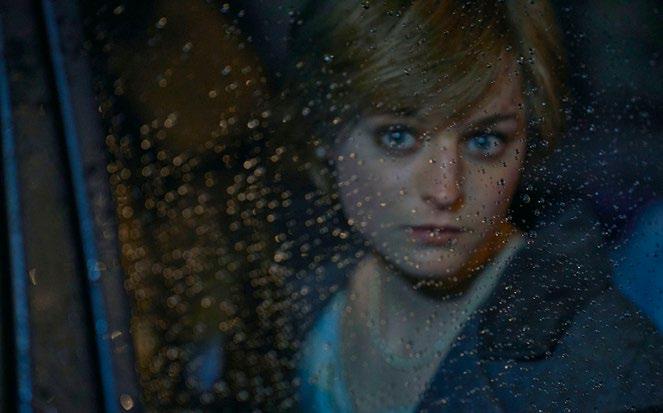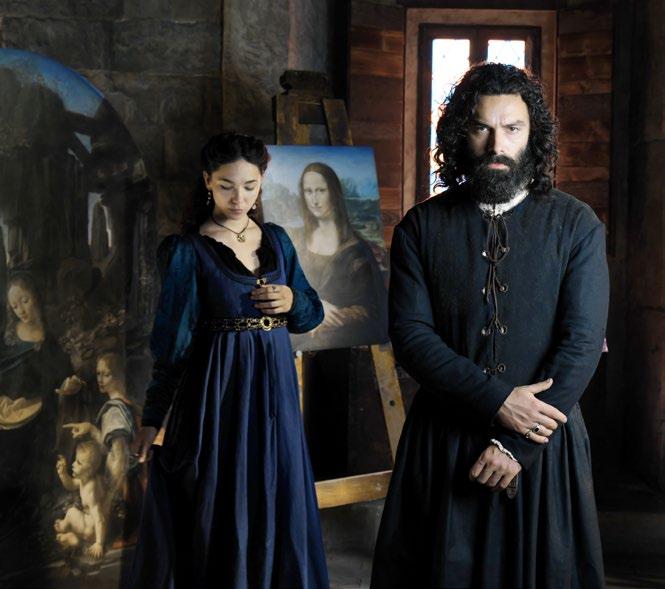
9 minute read
Our Friend in the West
As Bristol City Council’s new senior film manager, I have finally reached a position where I can support and promote my two main passions – Bristol and filming in the West Country.
My role is to oversee the work of the Bottle Yard Studios and Bristol Film Office, and make sure that Bristol can build on its past successes and deliver a single, complete and consistent offer encompassing studio and location filming. And, despite the pandemic, there has never been a better time.
Advertisement
Film and TV production is one of Bristol’s fastest growing businesses, and the studios, which are owned by Bristol City Council, play an integral role in that growth.
After 10 years of operations, the studios are now recognised globally as a thriving centre for production. Titles currently shooting include Stephen Merchant’s new BBC/Amazon Prime series The Offenders, starring Oscar-winner Christopher Walken, Netflix sci-fi series The Last Bus and Starz’s Becoming Elizabeth.
The city’s Film Office has consistently provided support for productions over the past 15 years. This has earnt Bristol the reputation of being one of the most film-friendly places to shoot in the UK. And it contributed to us winning Unesco City of Film status in 2017, and persuading Channel 4 to open its creative hub here in early 2020.
Producers return time and time again, for good reason. There are many
Laura Aviles explains why Bristol’s TV and film community is poised to play a vital role in the post-Covid economic recovery
Laura Aviles
benefits to being based here: it is less than two hours from London but, as a smaller city, Bristol is far quicker to navigate when shooting on location. Producers save precious time when units are in transit. Costs are lower, yet you will still find all the worldclass production, post-production and facilities companies you could possibly need.
Bristol Film Office goes above and beyond to assist with recces, permits and logistics, plus there’s a vast bank of experienced local crew who are only too keen to work closer to home.
Within the city, you’ll find a mixture of architecture, including Regency and Georgian terraces, large green spaces and gritty urban settings.
Bristol is the gateway to the West of England – Cornwall, Devon and Dorset offer a wonderfully varied selection of landscapes, historic houses and coastlines.
Like everyone else, we had to adapt quickly to create a safe production environment during the pandemic. We have a dedicated Covid-19 safety supervisor in place and we published our Covid-19 site operating procedures in June to support productions and TV/film-related businesses based here.
Our recovery in Bristol has been relatively fast. The city was the location of choice for some of the first UK high-end TV titles to restart filming after the first lockdown.
These included the BBC and Amazon’s Nancy Mitford adaptation, The Pursuit of Love, starring Lily James and Andrew Scott, and series 2 of Fox TV and StudioCanal’s War of the Worlds. Both were up and running again by late July/early August.
As streaming platforms and broadcasters ramp up their content, the need for additional stage space and skills is growing steadily. New studios are being built throughout the UK, and Bristol is not missing out. Plans for a £12m development have recently been approved, with the Bottle Yard growing from eight to 11 stages. If everything goes to plan, the new studios should launch late next spring.
Bristol is developing a skills agenda to grow a sustainable talent base to meet increased demand, and the city is set to be a key contributor to local and national economic recovery. n
Laura Aviles is Bristol City Council’s senior film manager.
The craft of telling a fairytale
How the makers of The Crown painstakingly created Diana Spencer’s emotional story for an outstanding episode of the Netflix series

W‘ e think we all know Diana’s story, but I always ask the question: what must it have one of the most famous women in the world, a person about whom everyone has an opinion”, noted Caron at last month’s RTS event “Deconstructing the Fairytale”. The episode is, arguably, a masterslightly cold, bruising, hurtful, lonely, locked-up pain. I love focusing on that uncomfortable stuff, that piece of gravel in the shoe. “[But,] across the season, we see that remarkable strength of character which been like for any person going through class in storytelling, especially when Diana possesses grow, and that power that experience – what she was thrown the story is world-famous. The script and resilience she has to rise above it all.” into at such a young age?” said Benja- was one of The Crown’s shortest, at just Joining Caron on the panel were min Caron, the director of the Fairytale over 30 pages, which allowed a greater production designer Martin Childs and episode of The Crown. emphasis on the telltale details of this hair and make-up designer Cate Hall, Therein lies the challenge of the third key moment in royal history. both integral to the episode. Emma episode of the fourth series of Netflix’s Laden with visual metaphors, it Corrin, who played Diana in the show, royal drama. A dramatisation loosely leverages every aspect available to a had to pull out of the panel due to a based on the royal family (and all the director to depict the emotional journey last-minute scheduling conflict, but more contentious for it), the episode’s behind Diana’s dramatic switch from her casting was the first and biggest central figure is Diana Spencer, who her old life to the new – and to fore- step in the process. accepts Prince Charles’s proposal and shadow the already-familiar events of “Casting Diana felt like no easy task moves from her Earl’s Court flatshare her life as a royal. until we met Emma. Very Diana-like, to Buckingham Palace in preparation “As a guiding principle, I like to focus she walked into the room and instantly for her new life as a princess. on the anthropological weirdness of captured everyone’s attention,” said The Crown’s blurring of fact and fic- these people and this institution,” said Caron. “She had this strength, this tion becomes trickier with, “arguably, Caron. “It always comes back to the incredible vulnerability, which is a hard
thing to play without being clichéd.”
Corrin’s depiction, and the freedom that the lean script afforded, combine in a revealing scene in which Diana practises ballet alone. Inspired by a similar scene in Billy Elliot (directed by Stephen Daldry, also an executive producer for The Crown) and soundtracked by a haunting use of Song for Guy by Elton John, Diana begins in a rigid, taught fashion.
But, as the emotions get the better of her, “it breaks out into her expression of her character, her personality, of her trying to push out against the walls
of the palace,” said Caron. “It’s raw, it’s emotional, it comes at a really difficult time for her, but it speaks volumes about her incredible ability to overcome.”
The scene was shot on a closed set, with loose direction. “I always talk about giving actors permission to fail, about allowing them to go further than they might do without the constraints of being judged,” said Caron. “It was just me and the camera, and we played Cher’s Believe. It didn’t matter because we were going to replace the music later on, but it was something Emma felt she could throw herself around the room to.”
This scene also highlights the role that production plays. For Corrin to be able throw herself around the room without restraint, her wig had to play its part by staying on and adding to the spectacle of her torment.
“We put a bald piece underneath the wig so, when she moves, you can see skin underneath, and the hair flicking out,” said Cate Hall. “Emma was so confident [in the wig] that there was never any reticence to do any of the moves. She didn’t have to think about the wig, ever.”
Although costume designer Amy Roberts ensured that the looks always matched the setting, the softness of her ballet outfit is noticeably at odds with the imposing room. “It’s the only time where the costume and the environment didn’t go together, and deliberately
didn’t go together, so she could carry on being a fish out of water,” explained Childs.
The metaphors in the set have underpinned The Crown, especially with the cold formality of Buckingham Palace. Childs revealed that, ahead of the first series, he went undercover as a tourist to tour the palace. He then recreated “the house” using a combination of 11 stately homes and four sets in Elstree Studios.
Look carefully and staircases tell their own story. When Diana leaves her flat for the palace, she leaves her friends behind and descends a staircase with blood-red walls. “Then, Ben had the brilliant idea of providing a counterpoint [by] doing a much grander version of it once she gets to the palace,” said Childs.
There, the apartment in which Diana is kept speaks of the “cold hospitality” provided by the royals. “I have a theory that they only dusted the apartment the week before she got there and, in the past, they kept it there for bridesto-be. That was my brief to myself and the set decorator.”
Diana’s appearance acts as a visual device, too. Said Hall: “We had to plot the journey strategically over 10 individual films, and Fairytale is a springboard into that journey. She’s full of hope, but we know it can’t end well. We almost had to tell the whole story in one episode.”
To begin with, “we went as minimal as possible. We kept everything soft, creamy, really round, to give her that adolescent vibe. Then, we used beauty make-up to age her though the series. So we used those nice 1980s trends with cool, glittery tones. We used angular blusher, blue eyeliner – all that stuff. That helped to underpin the emotional narrative, and also to give us somewhere to go to tell that whole story.”
But blue eyeliners presented a particular challenge. Because their colours change with different lenses and cameras, the crew needed to camera-test them all. “We turned up with a make-up shop’s worth of make-up and looked at every different blue on camera, because we had to save our punchiest blues for the end of her story,” said Hall.
Diana’s hairstyle has its own journey: three wigs were used over this series. “They’re all essentially the same haircut – it’s that unique Diana cut. But, as she moves through the series, the hair gets more processed and styled, with more highlights. By the end, it’s a real do.”
Diana’s fateful storyline will continue in the fifth series. As has become customary after two series, it is all change for the cast. Imelda Staunton takes over from Olivia Colman as Queen Elizabeth; Lesley Manville plays Princess Margaret, instead of Helena Bonham Carter, and Elizabeth Debicki (The Great Gatsby and Widows) will take the baton from Corrin to play Diana.
Both Hall and Childs are working on the upcoming series but, unsurprisingly, are tight-lipped about what’s to come. “I have this pile of scripts with my name watermarked on them, so I can’t divulge a thing. They’re juicy, aren’t they, Cate?” teased Childs.
We wouldn’t expect anything less. n

Netflix
Report by Shilpa Ganatra. ‘Deconstructing the Fairytale’ was an RTS event held on 24 March, chaired by presenter Anita Rani.








